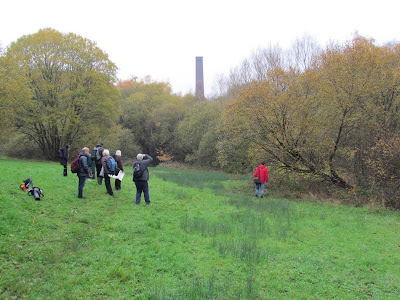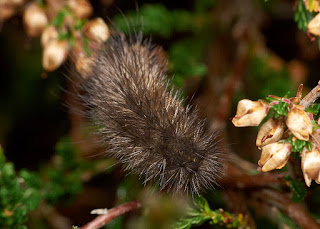Little did I suspect that a visit to Telford's Town Park on a grey day in mid-November would be so appealing. When we had assembled in the car park by Grange Pool at the south end of the park there were a baker's dozen folk within the group, including three newcomers (welcome all) and a couple who were re-appearing after a period of ill-health (welcome back).
I have long understood that my suggestions for where to go on the day are ignored so I plunged straight in ....
"Where do you want to go?"
"Stirchley Chimney" was the immediate response.
So with little further ado we set off and marched to the aforementioned feature of the park.
As we marched along I looked at the vegetation verging the path. Should I pause and do a bit of beating, or should I continue blinkered like the others.
Sorry, but I could not resist. I beat (halfheartedly) some ivy and out popped a small earwig with no visible wings and distinctive male claspers. I thought I knew what it was but I called our earwig expert for an expert identification. Yes ... I was right ... a Lesne's earwig.
 |
| Photograph: David Williams |
By now the rest of the group were so far ahead that they sent someone back to find out where we were.
We quickly rejoined the group in the grounds of the Stirchley Chimney.
What is a chimney doing in the middle of a park? Fortunately a helpful information board held the answers.
(Remember you can click on the photograph to open it in a new window so that it can be enlarged for reading.)
As you will see we did not need to measure the height of the chimney, the board informs us that it is approximately 209' high, built in 1873 by the Old Park Iron Co. using Randlay brick.
Then I got a bit of a shock. As I looked around the site I saw a building that I had no idea was there. Not just a small building but a huge construction.
One of the group had worked with the archaeologists involved in investigating the site so he gave an impromptu guided instructional tour.
A major attraction of this area was the presence of three picnic tables around which we established our encampment while we explored the site.
An early find was a Woolly milkcap.
 |
| Photograph: David Williams |
This attractive small beast is known as Katiannidae genus nov. species nov. a in the British list (http://urweb.roehampton.ac.uk/collembola/taxonomy/) but is Katiannidae genus nov.1 species nov.1 in the "world" list (http://www.collembola.org/frset.htm). In the British list it is described rather affectionately as a " spotty alien found in Richmond park.". Well it has spread from Richmond Park and has turned up in several sites in Shropshire.
The vacuum sampler was put to good use and its catches minutely examined.
The chimney is enclosed by a small semicircular wall with various shrubs planed on top. One was in flower.
I have no idea what it is but for once my attempt to photograph a flower was reasonably successful so I have included it to provide a bit of balance between the flora and fauna.
Lunch was taken (at the picnic tables) then we moved on to an area known a Fletcher's Pool and the meadow that leads down to it.
A couple of the group were lucky enough to catch a glimpse of a kingfisher as it flew across the pool, the rest of us had to make do with another view of the chimney.
After looking around the meadow and searching the accessible part of the pool edge we made our way back towards the car park but by a circuitous route that took us by the side of Grange Pool.
As we looked across the pool a duck landed amongst the mallards that was clearly not a mallard. Binoculars were employed and it was identified as a Mandarin duck.
The swan families nearby were not impressed and just got on with their lives.
We returned to our cars and home to get on with our lives.
My thanks to Telford and Wrekin Council for allowing us to pursue our interest in the Town Park and to David Williams for the additional photographs.










































































